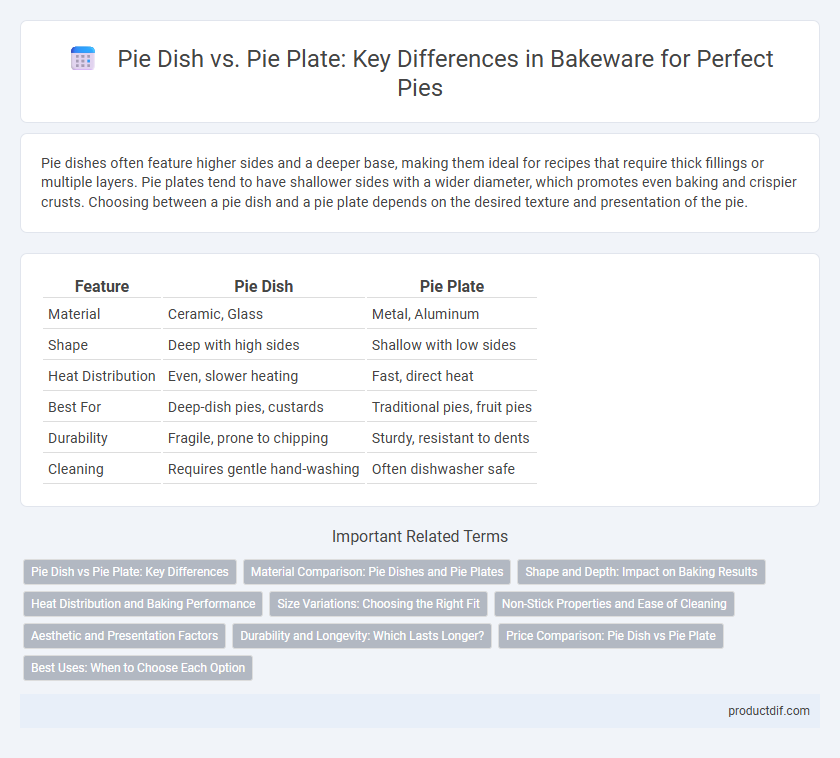Pie dishes often feature higher sides and a deeper base, making them ideal for recipes that require thick fillings or multiple layers. Pie plates tend to have shallower sides with a wider diameter, which promotes even baking and crispier crusts. Choosing between a pie dish and a pie plate depends on the desired texture and presentation of the pie.
Table of Comparison
| Feature | Pie Dish | Pie Plate |
|---|---|---|
| Material | Ceramic, Glass | Metal, Aluminum |
| Shape | Deep with high sides | Shallow with low sides |
| Heat Distribution | Even, slower heating | Fast, direct heat |
| Best For | Deep-dish pies, custards | Traditional pies, fruit pies |
| Durability | Fragile, prone to chipping | Sturdy, resistant to dents |
| Cleaning | Requires gentle hand-washing | Often dishwasher safe |
Pie Dish vs Pie Plate: Key Differences
A pie dish typically has deeper, sloped sides and is often made from ceramic or glass, providing even heat distribution for a tender crust and well-baked filling. In contrast, a pie plate usually features shallower, straight or slightly flared sides and is commonly crafted from metal, offering quicker heat conduction and crisper crust edges. Choosing between a pie dish and a pie plate depends on the desired crust texture and baking characteristics.
Material Comparison: Pie Dishes and Pie Plates
Pie dishes are often made from ceramic or glass, offering excellent heat retention and even baking, while pie plates are commonly crafted from metal, such as aluminum or stainless steel, providing faster heat conduction for crisper crusts. Ceramic pie dishes provide a non-reactive surface ideal for acidic fillings, whereas metal pie plates are lighter and more durable for frequent use. Choosing between the two materials depends on the baking preference for crust texture and temperature control precision.
Shape and Depth: Impact on Baking Results
Pie dishes typically feature sloped, deep sides that promote even heat distribution and allow for thicker fillings, enhancing crust crispiness and baking consistency. Pie plates have shallower, more uniform depths with gently curved edges, resulting in a thinner crust and expedited baking times due to increased surface exposure. The shape and depth directly influence moisture retention and caramelization, thereby impacting texture and flavor development in baked pies.
Heat Distribution and Baking Performance
Pie dishes typically feature thicker ceramic or glass materials that provide even heat distribution, ensuring a uniformly baked crust and filling. Pie plates, often made from metal, conduct heat more quickly and intensely, resulting in a crispier crust but requiring closer temperature monitoring to prevent burning. Understanding the material composition impacts baking performance, as ceramic pie dishes maintain steady heat for delicate fillings while metal pie plates excel at producing golden, flaky crusts.
Size Variations: Choosing the Right Fit
Pie dishes typically come in deeper sizes ranging from 8 to 10 inches, ideal for pies with thick fillings or crumb toppings, while pie plates are shallower and often measure 9 to 11 inches, designed for even baking and crisp crusts. Selecting the right size depends on the recipe's thickness and desired crust texture, as deeper dishes can affect baking times and heat distribution. Understanding these size variations ensures optimal results whether making fruit pies, custards, or savory tarts.
Non-Stick Properties and Ease of Cleaning
A pie dish typically features a glazed ceramic surface that offers moderate non-stick properties but may require greasing to prevent sticking, while a pie plate, often made of metal with a non-stick coating, provides superior non-stick performance and easier food release. Non-stick pie plates facilitate quicker cleanup due to their smooth, coated surfaces resisting residue buildup, whereas ceramic pie dishes might retain baked-on bits, demanding more thorough scrubbing. Choosing between a pie dish and a pie plate depends largely on the balance of aesthetic preference and practical ease of cleaning and non-stick functionality.
Aesthetic and Presentation Factors
Pie dishes typically feature deeper walls and often come with decorative fluting or patterns on ceramic or glass surfaces, enhancing visual appeal during serving. Pie plates, usually made of metal with shallower sides and a smooth finish, provide a more minimalist and utilitarian look that emphasizes the pie's crust and filling colors. Choosing between a pie dish and pie plate can significantly influence the presentation style, with dishes offering a rustic charm and plates delivering a sleek, modern aesthetic.
Durability and Longevity: Which Lasts Longer?
Pie dishes, often made from ceramic or glass, tend to offer superior durability due to their resistance to scratches and heat damage, making them ideal for long-term use in baking. Pie plates are frequently constructed from metal or disposable materials, which may be less durable and prone to warping or rust over time, limiting their longevity. Choosing a high-quality ceramic pie dish can ensure years of consistent performance compared to metal pie plates that might degrade faster under frequent oven use.
Price Comparison: Pie Dish vs Pie Plate
Pie dishes generally cost more than pie plates due to their thicker ceramic or glass construction, which offers better heat retention and even baking. Basic metal pie plates are more affordable and widely available, making them a budget-friendly option for everyday baking. Choosing between the two depends on balancing cost with durability and performance for specific baking needs.
Best Uses: When to Choose Each Option
Pie dishes, typically deeper with sloped sides made from ceramic or glass, are ideal for fruit pies or custards requiring even heat distribution and moisture retention. Pie plates, usually shallower with straight sides and often metal, excel for flaky-crusted pies or savory quiches that benefit from rapid browning and crisp edges. Choose pie dishes for delicate fillings that need gentle, uniform cooking, while pie plates suit recipes needing a crisp, golden crust and faster bake times.
Pie dish vs Pie plate Infographic

 productdif.com
productdif.com